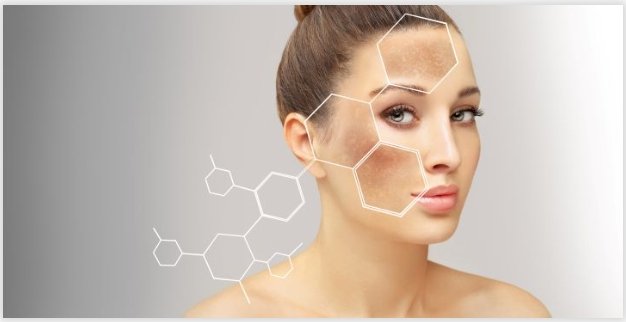Hyperpigmentation refers to the darkening of certain areas of the skin due to an excess production of melanin, the pigment responsible for the color of our skin, hair, and eyes. There are various causes of hyperpigmentation, and treatment options depend on the underlying cause and the severity of the condition. Here’s an overview of common causes and treatments for hyperpigmentation:
Causes of Hyperpigmentation:
- Sun Exposure: Sun exposure is one of the primary causes of hyperpigmentation. Overexposure to the sun’s UV rays can lead to the development of sunspots, also known as solar lentigines or age spots.
- Post-Inflammatory Hyperpigmentation (PIH): PIH occurs after skin inflammation or injury, such as acne, burns, cuts, or insect bites. It results in darkened areas of skin at the site of the injury.
- Melasma: Melasma is a type of hyperpigmentation characterized by brown or gray-brown patches, typically on the face, that are often triggered by hormonal changes, pregnancy, birth control pills, or sun exposure.
- Medications: Some medications, such as certain antibiotics, anti-seizure drugs, and nonsteroidal anti-inflammatory drugs (NSAIDs), can cause drug-induced hyperpigmentation as a side effect.
- Hormonal Changes: Hormonal fluctuations, particularly in women, can lead to an increase in melanin production, resulting in conditions like melasma and chloasma. Refer to a Best Dermatologist in Islamabad to know more.
Treatment Options for Hyperpigmentation:
Sunscreen: Sunscreen is essential for preventing and managing hyperpigmentation. Use a broad-spectrum sunscreen with SPF 30 or higher daily, even on cloudy days, to protect your skin from UV damage.
Topical Lightening Agents:
- Hydroquinone: A skin-lightening agent that can help reduce the appearance of hyperpigmentation. It is available in both over-the-counter and prescription formulations.
- Retinoids: Topical retinoids, like tretinoin, can help improve skin texture and reduce the appearance of hyperpigmentation.
- Vitamin C: Vitamin C serums can have a brightening effect on the skin and may help fade hyperpigmented areas.
- Niacinamide: This ingredient can help reduce the appearance of dark spots and improve overall skin tone.
- Chemical Peels: Chemical peels involve the application of an acid solution to exfoliate the top layers of skin. They can be effective for treating mild to moderate hyperpigmentation.
- Microdermabrasion: This procedure uses a machine to exfoliate the outermost layer of skin, which can improve the appearance of hyperpigmentation.
- Laser Therapy: Various laser and light-based therapies, such as intense pulsed light (IPL) and fractional laser treatments, can target and reduce hyperpigmented areas.
- Microneedling: Microneedling involves tiny needles that create controlled micro-injuries to the skin, stimulating collagen production and improving the appearance of hyperpigmentation.
- Topical Steroids: In some cases, topical steroids may be prescribed by a dermatologist to reduce inflammation and pigmentation.
- Prescription Medications: Your dermatologist may prescribe prescription-strength treatments for severe cases of hyperpigmentation.
- Camouflage Makeup: High-quality makeup products can help conceal hyperpigmentation temporarily.
It’s important to note that the effectiveness of these treatments may vary depending on the type and severity of hyperpigmentation. Also, some treatments may require multiple sessions or a combination of approaches for optimal results. Consult with a dermatologist to determine the most suitable treatment plan for your specific condition. Additionally, be patient, as it can take several weeks or months to see significant improvement in hyperpigmentation.
